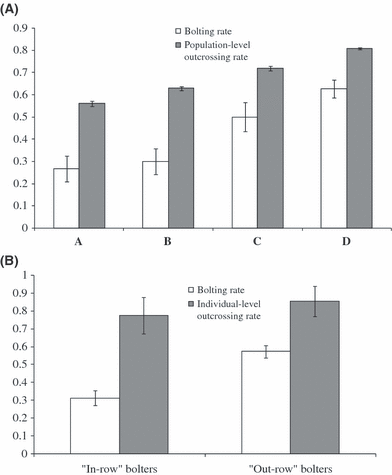Populations of weedy crop-wild hybrid beets show contrasting variation in mating system and population genetic structure
- PMID: 25567926
- PMCID: PMC3352460
- DOI: 10.1111/j.1752-4571.2010.00121.x
Populations of weedy crop-wild hybrid beets show contrasting variation in mating system and population genetic structure
Abstract
Reproductive traits are key parameters for the evolution of invasiveness in weedy crop-wild hybrids. In Beta vulgaris, cultivated beets hybridize with their wild relatives in the seed production areas, giving rise to crop-wild hybrid weed beets. We investigated the genetic structure, the variation in first-year flowering and the variation in mating system among weed beet populations occurring within sugar beet production fields. No spatial genetic structure was found for first-year populations composed of F1 crop-wild hybrid beets. In contrast, populations composed of backcrossed weed beets emerging from the seed bank showed a strong isolation-by-distance pattern. Whereas gametophytic self-incompatibility prevents selfing in wild beet populations, all studied weed beet populations had a mixed-mating system, plausibly because of the introgression of the crop-derived Sf gene that disrupts self-incompatibility. No significant relationship between outcrossing rate and local weed beet density was found, suggesting no trends for a shift in the mating system because of environmental effects. We further reveal that increased invasiveness of weed beets may stem from positive selection on first-year flowering induction depending on the B gene inherited from the wild. Finally, we discuss the practical and applied consequences of our findings for crop-weed management.
Keywords: Beta vulgaris; genetic structure; invasive species; outcrossing rate; timing of flowering; weediness.
Figures



References
-
- Arnaud J-F, Viard F, Delescluse M, Cuguen J. Evidence for gene flow via seed dispersal from crop to wild relatives in Beta vulgaris (Chenopodiaceae): consequences for the release of genetically modified crop species with weedy lineages. Proceedings of the Royal Society of London B. 2003;270:1565–1571. - PMC - PubMed
-
- Arnaud J-F, Fénart S, Godé C, Deledicque S, Touzet P, Cuguen J. Fine-scale geographical structure of genetic diversity in inland wild beet populations. Molecular Ecology. 2009;18:3201–3215. - PubMed
-
- Baker HG. The evolution of weeds. Annual Review of Ecology & Systematics. 1974;5:1–24.
-
- Barrett SCH, Colautti RI, Eckert CG. Plant reproductive systems and evolution during biological invasion. Molecular Ecology. 2008;17:373–383. - PubMed
LinkOut - more resources
Full Text Sources

